William Watkins (architect)
| William Watkins | |
|---|---|
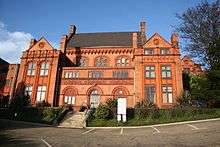 Christ's Hospital Girls School, LIncoln | |
| Born |
1834 Rushock, nr. Droitwich, Worcestershire |
| Died |
1926 Lincoln |
| Nationality | English |
| Alma mater | Articled to Henry Day of Worcester 1854–59 |
| Occupation | Architect |
| Buildings | Christ's Hospital Girls School, Lincoln |
William Watkins (1834–1926) was an architect who worked in Lincoln, England, and is particularly noted for his Terracotta Revival Architecture.
Career
Watkins was articled to the Worcester architect Henry Day between 1854 and 1859, and he then worked as principal assistant to the Lincoln architect Henry Goddard between 1860 and 1864. He set up his own practice St Edmond's Chambers, Silver Street, Lincoln in 1864 and was living at Leyland House Lincoln in 1881. Between 1877 and 1883 he was in partnership with William Scorer Two of his sons, Henry (or Harry) Garnham Watkins and William Gregory Watkins, also became architects. Harry Garnham Watkins (1870/1-1956), joined the practice of Albert Nelson Bromley, formed the partnership of Bromley and Watkins from 1912 to 1928, and was to become a leading architect in Nottinghamshire.[1] His elder brother William Gregory (1869-1859) was articled to his father and became a partner with his father in 1897. He was elected FRIBA in 1881 and also became a Lincoln Diocesan Surveyor.[2] His father retired from the practice in 1918, and it was continued by his son W. G. Watkins until 1934, when Bob Coombes (1900-1968) became a partner. The practice had moved to Heslam Chambers, 191 High Street, Lincoln by 1959. The practice later moved to 4 Burton Road Lincoln (now the Bronze Pig restaurant), and it ceased operating about 1990.
Watkins' Architectural Practice
- William Watkins 1864-1881.
- Watkins and Scorer. 1877-1883
- Watkins and Son (W.G Watkins).
- Watkins and Coombes (1934–48)
- Watkins, Coombes & Barrell 1948-1951
- Watkins, Coombes & Partners 1951-
Works include
Public buildings
It is suggested by Antram that the Lincoln Drill Hall was by Watkins[3] The attribution is incorrect – the architect was Henry Goddard.
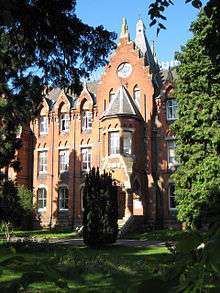
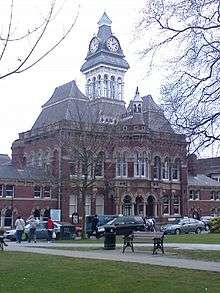
- Royal Albert Orphanage, Henwick, Worcester. 1868. The building cost £5,000 and the contract was won by Watkins in open competition.[4] Funds were raised for the construction of permanent premises for the institution, with a donation of £4,000 being received from local MP Alderman Richard Padmore, and legacy of £1,000 in 1866 from Mr Edward Wheeler. A site was obtained on Henwick Road, Worcester, and a competition held for designs for the new building. The plans put forward by William Watkins and Samuel Dutton Walker were chosen.
- Grantham Town Hall, Grantham. 1867–69. This is an early work by Watkins in an Italianate/ Jacobethan revival style with stone dressing and florid Corinthian columns surmounted by a clock tower giving a heavy and ungainly appearance.[5] The Guildhall, as originally designed, was made up of three separate buildings – the main building, which housed a ballroom and courtroom (or session's hall); a governor's residence and a gaol for up to 18 men and women on two floors. The work was carried out Mr Wartnaby, of Little Gonerby, for £7,260. In 1991 it was redesigned by the Sleaford architect Tim Benton and re-opened as the council owned Guildhall Arts Centre at a cost of £1.2 million.[6]
.jpg)
- The Market Hall, Corn Exchange and Fish Market, Doncaster. The impressive facade and arched Exchange buildings were built to the designs of Watkins]] of Lincoln, who won an architectural competition in 1870. It is set within an earlier U shaped Market Hall structure of 1847-9 by J Butterfield, the architect to Doncaster Corporation. The Corn Market, Market Hall and Fish Markets were further extended in 1930 and the overall complex is Grade II listed.[7] The Corn Exchange has advanced central and side bays with projecting stonework to corners, acting as plinths for clasping) corner pilasters and adjacent engaged red sandstone columns to first floor. The balustrade to front has a plinth inscribed Wm Cotterill Clark Mayor 1873. The interior of the corn exchange is very elaborate with a gallery supported on a round arched arcade with alternating plain and panelled pilasters between the arches. Galleries to sides have paired iron columns with foliate capitals supported by round arches of pierced ironwork with sumptuous decoration to the spandrels. Roof with iron arched trusses with decorative bracing, with a large central ridge light supported on foliate trusses.[8]
- General Dispensary, Silver Street, Lincoln. 1879. By Watkins and Scorer. (This was on the south side of Silver Street and was demolished about 1963.)[9]

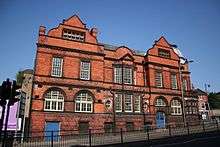
- Outpatients at Lincoln County Hospital, Sewell Road, Lincoln. 1891.[10]
- Masonic Hall and Concert Room, Newland, Lincoln (1871).Originally built for the Masonic Hall Company. This was not a successful venture and the project became insolvent around 1888.[11] Gothic revival style. Later Palace Theatre and then Plaza Cinema. It was demolished as a result of a fire in the 2nd World War.[12]
- Constitutional Club, on corner of Broadgate with Silver Street, Lincoln 1895. With a domed circular vestibule at the corner and enriched with terracotta work presumably from Ruabon.[13]
- County Assembly Rooms, Bailgate, Lincoln. 1914. Watkins added a new facade to this building with a Venetian window set in the gable above the entrance. The building contains a fine interior dating from 1745[14]
Banks
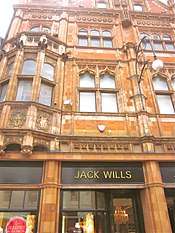
.jpg)

- Peacock and Willson's Bank, 190-1, High Street Lincoln. 1897. (Now Jack Wills). This building is an important example of FlemishGothic revival style and is probably Watkins finest work. Watkins provided the drawings used to fashion the elaborate terracotta mouldings which were provided by Doulton and Company, probably from their production plant at Rowley Regis in the West Midlands. It was restored to its original appearances at street level in 1992.[15][16][17]
- HSBC, High Street Lincoln, 1893. Formerly the Lincoln and Lindsey Bank, later Midland Bank, The earlier building was occupied by Hepworths the clothiers. Watkins left the upper part of the building untouched, but the exterior walls and the ground and first floors were removed and the stone facade and strongroooms were inserted. The new banking hall has an impressive ceiling with Elizabethan style strap-work decoration and the coats of arms of the Lincolnshire Boroughs. The building was extended between 1923 and 1926.[18]
- Sleaford. The Midland Bank (now HSBC) was built in 1903, designed by William Watkins and Son, in a stone faced Jacobethan/Renaissance Revival style with shaped gables and oriel windows. The ground floor entrance at the corner of Westgate with Southgate Street has a heavily moulded entrance with a corner tower above and the ground floor windows are set between columns.[19]
- Lloyd's Bank, Northgate, Sleaford 1905. Baroque revival.[20] Formerly Peacock Willson & Co Bank which was established in 1792 in a house built in 1702 for Robert Alvey. Watkins and Son extended this building in a matching architectural style to the north of the original building which is adjacent to the Sleaford Sessions house.The new building was technically advanced, heated with low pressure hot water with electric lighting throughout. The 9 foot diameter glass dome in the centre of the banking chamber was fitted with a patent air extractor.[21]
The HSBC Bank, Lincoln, Gallery: work by Watkins
- HSBC Lincoln
 HSBC Bank Lincoln
HSBC Bank Lincoln HSBC Bank Lincoln
HSBC Bank Lincoln HSBC Bank Lincoln
HSBC Bank Lincoln HSBC Bank Lincoln
HSBC Bank Lincoln
Shops

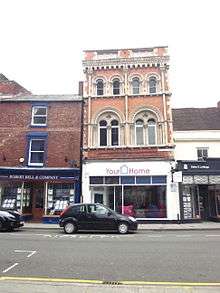
- 42 Silver Street, Lincoln. 1873. Originally built as a warehouse by William Watkins for Mr J Harrison[22] and in 1896 was Lincoln Working Man’s Conservative Club.[23] An example of Romanesque Revival Architecture in the Florentine style. Brick with stone dressings. Three storeys. Quoins, bracketed stringcourses, wavy corbel table, billeted frieze, pierced, balustrade, ringed wall shafts.[24]
- 305/6 High Street, Lincoln. 1900, designed for Hewitt Brown & Co. (Now Fat Face). Brick with terracotta dressings-terracotta dressings were made by the Hathern Station Brick Co. of Loughborough. Flemish Renaissance Revival style. Giant pilasters, those at the angles with domed finials, enriched moulded cornice and coped gable. 4 storeys plus attics, 3 bays. Windows have terracotta mullions and transoms. Fascia with a full width glazed panel above it. Above, window flanked by single bow windows, and above that a gable has a 4-light ogee-headed window with a blind arcade and a latticed round-headed opening in the gable peak, flanked by pilasters with domed finials.
- 216 High Street Lincoln. 1902. Shop for C. J. Fox and Co. This has been demolished and is now the site of Primark.
Restoration work

- Greyfriars, Free School Lane (formerly the City and County Museum). Watkins converted the undercroft of the Franciscan Friary into a museum in 1909.[25]
- The High Bridge, Lincoln. The 16th-century jettied timber framed shops on the bridge were partly dismantled and re-erected by Watkins in 1900–01.[26]
Churches
- St. Mark, High Street Lincoln 1871–72. Large church in 13th. century style without aisles and with lancet windows and tracery. Slender north tower with spire.[27]
- St Botolph, High Street, Lincoln. Nave and north aisle 1861, by Henry Goddard. The chancel was rebuilt in 1878, and the south aisle and south chapel added 1884 by William Watkins. Dressed stone and ashlar with slate roof.[28]
- South Carlton, Lincolnshire, The Monson Mausoleum was added to the north transept or chapel of South Carlton Church by Watkins in 1897–98.[29]
Schools
- Grammar School, Lindum Terrace, Lincoln (now Lincoln Minster School) 1884. The school was designed by Watkins in 1883–84 and was moved from this site to Wragby Road in 1906. It became the St Joseph Convent School and is now part of the Lincoln Minster School. Lincoln Minster School was formed in 1996 through a merger of the Cathedral School for Boys, St Joseph's School for Girls and Stonefield House School.[30]
- Christ's Hospital School for Girls, Lincoln. 1893 and extended in 1911.This is a particularly fine example of Romanesque Revival architecture in the United Kingdom After 1974 the building became part of Lincoln School of Art. It is built in red brick with Ruabon terracotta ornamentation.[31]
- St Peter in Eastgate Primary School, Eastgate, Lincoln. A further school was built on this site by Watkins in 1881 which was later combined with the earlier school of 1851 by William Adams Nicholson[32]
- Spring Hill National School, Hungate, Lincoln. 1910. School buildings now converted into the Ropery housing development.[33]
- Monk's Road Primary School, Lincoln. 1903/4 and later extended. A similar datestone to the Spring Hill School is above the gable window on this school.[34]
- Sincil Bank School, Lincoln. 1912.[35]
Houses
.jpg)
- House for William Old. Lindum Terrace,Lincoln. 1864.[36]
- House on the Strait, Lincoln, 1868. Opposite the Jews Court, built for himself.[37]
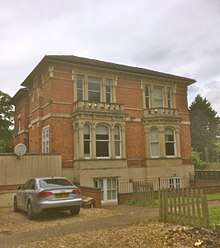
- 77 South Park, Lincoln. A house built for the Lincoln industrialist Robert Robey in 1871. This overlooks the South Common.[38]
- Burton Hall, Burton by Lincoln. Altertions and additions for Lord Monson in 1872, including the design of the gates.[39]
- Leyland House, 2 The Grove, Nettleham Road, 1875. Watkins' family.home.
- Boultham Hall, Lincoln. 1872. Alterations and restoration work to the Hall for Major Ellison. Now demolished.[40]
- Willoughby Hall, Ancaster, 1876. A house designed in 1873 by Watkins for F. W. Allix. In Jacobethan style with shaped gables and showing French renaissance. The house was completed by 1875 at an estimated cost of £28,000. The estate was sold in 1912 and again in 1928 The sale particulars show that it had a lofty hall with four main reception rooms with elaborate carved fireplaces, a smoking room, a broad staircase leading to a first floor with eight main bedrooms and nine bedrooms on the second floor. During World War II it was occupied by the army and was then used for bombing practice by the RAF. It was finally destroyed with dynamite in 1963. The stable block, dated 1876 survives and was converted into a house in 2010.[41][42][43]
- St Nicholas Parsonage, Newport, Lincoln 1879. Early Arts and Crafts. Built for the Rev F.B.Blenkin for £1950 plus £100 architect's commission.[44]
- Nettleham Hall, Nettleham. 1876. Destroyed by fire in 1937 and now in ruins.
- 1885 15-25 West Parade, Lincoln, for Charles Tomlinson, local chemist and property owner, most are in original condition, complete with boundary walls and railings. Built as town houses but all are now offices
- 1885 5 - 15 Beaumont Fee, Lincoln. For Charles Tomlinson. Built as town houses but all are now offices
- Canwick House, Canwick, Lincolnshire. 1889. now Canwick House Care Home. Red brick, terracotta, with decorativeterracotta panels and gables. Built as Canwick Rectory in a Queen Anne Revival, or Dutch Revival, style.[45]
- 1896. 9/11 Lindum Terrace,Lincoln. Arts and Crafts with timbering and pargeting.[46]
References
- ↑ "Brodie" Vol. 2, pg. 928
- ↑ "Brodie" Vol. II pg 925
- ↑ "Antram", (1989), 521.
- ↑ "Scorer" (1990), 38.
- ↑ "Antram", (1989), 322.
- ↑ Guildhall Arts Centre
- ↑ Sheardown W (1979) The Marts and Markets at Doncaster, their rise, progress, sources and supply.
- ↑ British Listed Buildings
- ↑ "Scorer" (1990), 40.
- ↑ "Antram", (1989), 510.
- ↑ DiXon J (1894) Freemasonry in Lincolnshire, pg. 178. William Watkins was a member of the Witham Lodge of Freemasons in Lincoln.
- ↑ Yeates-Langley A.(1997), Lincoln: A Pictorial History, Phillimore, Pl.111
- ↑ "Antram", (1989), 521.
- ↑ "Antram", (1989), 516.
- ↑ "Stratton" (1993), 230
- ↑ "Antram", (1989), 524.
- ↑ British Listed Buildings
- ↑ "Scorer" (1990), 41.
- ↑ "Antram", (1989), 655.
- ↑ "Antram", (1989), 656.
- ↑ "Scorer" (1990), 46
- ↑ Survey of Lincoln, City Building Applications no. 413- 04/03/1873
- ↑ White's Directory,1896, pg 356
- ↑ "Antram" (1989) pg.521
- ↑ "Antram", (1989), 508.
- ↑ "Antram", (1989), 523.
- ↑ "Pevsner" & "Harris" (1964), 143-4.
- ↑ British Listed BUildings
- ↑ "Antram", (1989),661-2.
- ↑ "Antram", (1989), 521.
- ↑ "Antram", (1989), 509.
- ↑ "Antram", (1989), 525. where incorrect information is given: see also
- ↑ LARA - conversion 2003, Stamford Homes
- ↑ "Scorer" (1990), 44. Unfortunately this datestone has been recently been covered by a signboard.
- ↑ "Scorer" (1990), 47.
- ↑ "Scorer" (1990), 38.
- ↑ "Scorer" (1990), 38.
- ↑ Survey of Lincoln, City Building Applications 06/11/1871
- ↑ "Scorer" (1990), 39.
- ↑ "Scorer" (1990), 39.
- ↑ “Antram" (1989), pg101
- ↑ Leach T.R and Pacey R.(1992). Lost Lincolnshire Country Houses, Vol.2, pp69-80.
- ↑ "Scorer" (1990), 39.
- ↑ "Scorer" (1990), 40.
- ↑ "Antram", (1989), 210.
- ↑ "Scorer" (1990), 42.
Literature
- Antram N (revised), Pevsner N & Harris J, (1989), The Buildings of England: Lincolnshire, Yale University Press.
- Brodie A. (ed), Directory of British Architects, 1834–1914: 2 Vols, British Architectural Library, Royal Institute of British Architects, 2001.
- Pevsner N & Harris J, (1964), The Buildings of England: Lincolnshire, Penguin, London.
- Scorer S.(introduction), (1990) The Victorian Facade: William Watkins and son, architects, Lincoln 1858-1918 Lincolnshire College of Art and Design. ISBN 0951634003. Booklet to accompany exhibition at the Usher Gallery, Lincoln.
- Stratton, M. (1993) The Terracotta Revival : Building Innovation and the Image of the Industrial City in Britain and North America. London : Gollancz.
- Welsh C. (1983), William Watkins (1834-1926): His Life and Work, Degree dissertation, Nottingham University Department of Architecture.
External links
| Wikimedia Commons has media related to William Watkins (architect). |